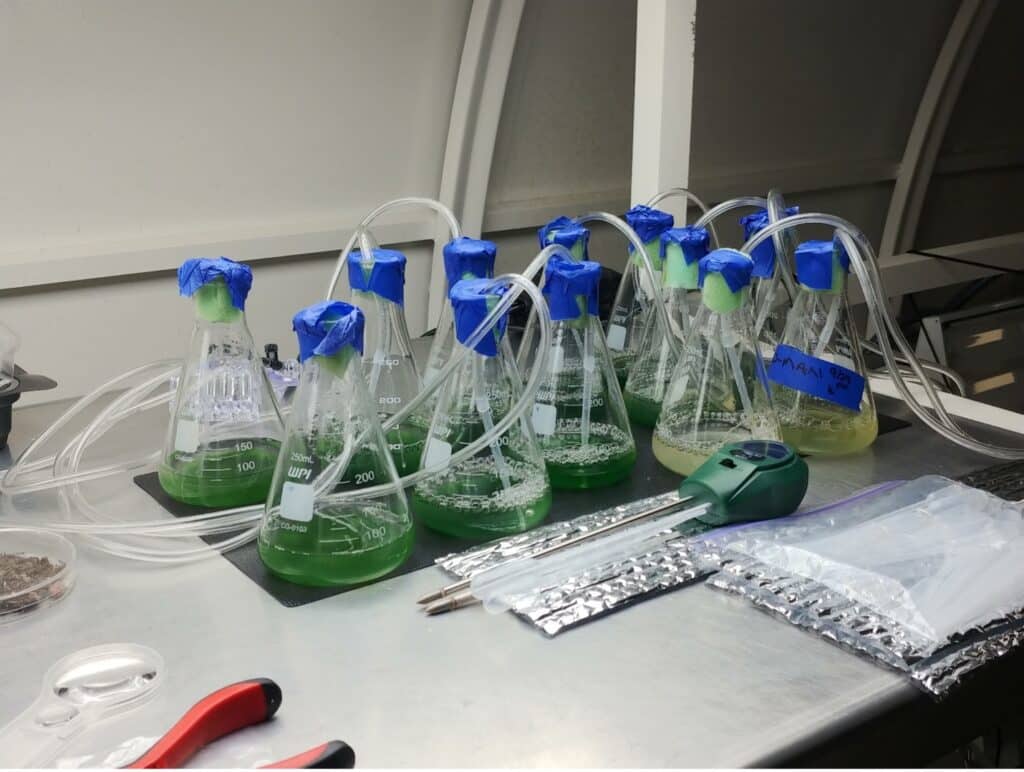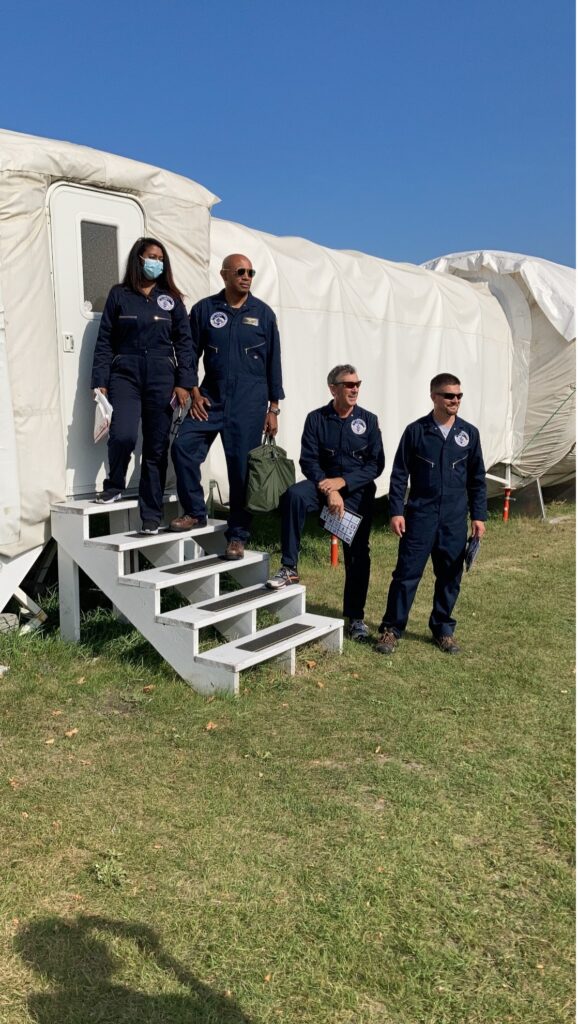By Dr. Kristen Miller
Faculty Member, Space Studies
Note: This article is part 3 of a three-part series about four members of the University community taking part in an analog mission as a research project for the University’s chapter of the American Institute of Aeronautics and Astronautics (AIAA). Their experience, activities and research will be detailed in this series.
Research at ILMAH
One of the most important parts of an analog mission is the opportunity to perform useful research that will ultimately impact NASA astronauts. Crew members work both individually and as a group to investigate a wide variety of research topics relevant to off-world settlements.
This research helps NASA to both develop techniques and test solutions to advance space exploration. The research also provides a chance to demonstrate feasible working procedures and schedules within the confines of an analog mission. Both are vital to ensuring the success of future space missions and can lead to more efficient, productive working conditions for astronauts.
The ILMAH crew participated in a wide range of research during their 11-day mission in North Dakota. Each crew member developed their own research projects, in addition to collaborating on group research and participating in research studies for University of North Dakota graduate students.
Habitat Design and Evaluation
ARG-1 Mission Commander Bill O’Hara is a specialist in habitat design. As a principal systems engineer for the Sierra Space Advanced Development Group, his professional work focuses on human space habitat architecture development.
His expertise and research interests led Bill to propose a case study of ILMAH, evaluating the habitat’s architecture and its use and allocation of space. Other considerations were habitat operations and human factors.
Using a combination of crew surveys, module measurements, and an analysis of traffic patterns within the habitat, Bill created a set of recommendations for optimizing ILMAH’s space by including additional science facilities and further improvements to the habitat. This research will contribute to the success of future ILMAH missions.
Experimenting with Spirulina Growth
Arthrospira platensis, more commonly known as spirulina, is a type of algae that has many potential benefits for space settlements. It is a robust microorganism, propagates quickly and consumes carbon dioxide efficiently while creating oxygen. Spirulina may also help support the growth of other plants in a space environment, and it may have applications as a nutritional supplement in astronaut diets.
Terry Trevino, the ARG-1 Science Lead, planned a research project to determine if spirulina could survive unmonitored travel to reach ILMAH. Terry also sought to determine if analog astronauts without advanced knowledge of biology could grow and harvest spirulina, using only the general resources available in a space habitat.
The spirulina sample survived five days of travel to reach ILMAH. During this time, it had only very limited gas exchange and no source of light, both of which are required for healthy growth.
The algae sample arrived at ILMAH in a state of extreme stress, but it was able to slowly revive after three days of care in ILMAH’s greenhab module. By day six, exponential growth was observed in the samples, and two harvest cycles were completed during the mission.
Terry’s experiment showed that spirulina is capable of surviving harsh conditions during transport and can thrive in an analog environment. Further work is being done to determine the growth rate and properties of spirulina in both Earth-based and space-based environments.
Growing Tall Fescue Grass
Tall fescue grass is a fast-growing variety that can withstand extreme environments. It is an ideal candidate for growth in analog habitats, where the grass can help to provide oxygen for the crew.
“One acre of trees produces oxygen for eight to 18 people, but one acre full of grass will provide enough for 70 people.” – Rose Worku, ARG-1 Science Specialist
At ILMAH, Rose Worku investigated the growth rate of tall fescue grass in simulated Martian regolith. Finding ways to grow plants using on-site resources, as opposed to terrestrial soil that would have to be transported from Earth, is key to the success of future Mars exploration.

One of the issues with Martian regolith is that it becomes cement-like once the regolith has been in contact with water, which can obstruct airflow to the grass seeds. Rose solved this problem by using tubing and an air pump to circulate ambient air through a mixture of soil and simulated Martian regolith. By increasing the number of hours of light the pots received, Rose decreased the germination time and produced sprouts within the mission timeframe.
Testing the Effectiveness of Online Learning from ILMAH
Understanding the culture of online learning is becoming increasingly important in today’s world. There are important advantages and disadvantages to online learning, many of which are strongly dependent on students’ learning style as well as ethnic, economic, and cultural factors.
Online learning is especially important in space exploration, where unexpected situations may arise that require “on the job” instruction from a distance. Updates and technological improvements developed during the mission may require additional remote training for crews as well.
Diallo Wallace, ARG-1 Engineer, tested the effectiveness of online instruction from ILMAH by teaching engineering and technical subjects to a group of students of varying learning types. His ongoing research was intended to determine which learning types will be best suited to succeed in long-term space missions.
Facial Emotion Recognition Research
While at ILMAH, the ARG-1 crew participated in a facial emotion recognition study run by Scott Van Hoy, the ARG Program Manager. This research involved a long-term study investigating whether emotion recognition speed and/or accuracy decreases are unique to microgravity environments such as during head-down bed rest analog studies. The research’s intent was also to learn if future lunar and Martian astronauts could experience a similar degradation in the ability to recognize facial emotions, due to the stresses involved in isolated environments.
Participants in head-down bed rest studies show a rapid decay in the ability to recognize facial expressions. During long-duration space flight, decreases in emotion recognition are a noteworthy risk because astronauts will be pushed to their emotional and psychological limits during a mission.

The emotion recognition research will help NASA researchers to determine the role isolation plays in the decline in facial emotion recognition and whether countermeasures against the degradation of emotion recognition should be pursued for future space missions. The ARG-1 crew conducted daily computer-based emotion recognition tests during the weeks prior to, during and after their mission.
The results at ILMAH clearly showed general shifts in how negative valence and neutral emotions are perceived. As the study is continued during future missions, these shifts can be quantified and validated to determine the significance of the effects.
The research performed by the ARG-1 crew during their ILMAH mission is exciting and relevant to the future of space exploration. Many of these studies will be continued in future analog missions. The experience of designing, performing and evaluating significant scientific research is invaluable for the students who participate in the mission.
“The first analog mission through our partnership with UND was a very fulfilling experience; the success of the mission demonstrates our ability to add quality research results for the analog community. It also adds value to our Space Studies program and validates our curriculum.” – Diallo Wallace
About the Author
Dr. Kristen Miller is an associate professor of Space Studies. She holds a B.S. in physics from Brigham Young University, a M.S. in astronomy from the University of Maryland, College Park, and a Ph.D. in astronomy from the University of Maryland, College Park. Her thesis work studied turbulence in magnetic fields in the protostellar disks surrounding young stars using supercomputer simulations, investigating both the ways in which turbulence allows angular momentum transport within the disks and how coupling of the gas to the field influences the direction of the accretion flow onto the protostar.
Currently, Dr. Miller leads the Analog Research Group, which recruits and trains teams of students to participate in analog research missions. She also leads the Supernova Search Program, a program dedicated to detecting supernovae and other transient objects in nearby galaxies.
Dr. Miller is the faculty advisor of the student chapter of the American Institute of Aeronautics and Astronautics (AIAA). She also serves on a variety of committees at the university.
